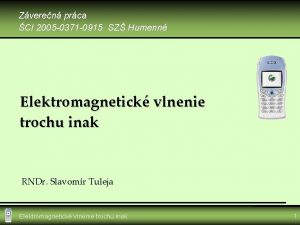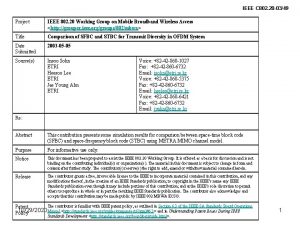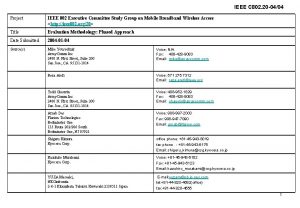IEEE C 802 20 0371 Project IEEE 802










- Slides: 10

IEEE C 802. 20 -03/71 Project IEEE 802. 20 Working Group on Mobile Broadband Wireless Access http: //grouper. ieee. org/groups/802/20 Title Evaluation criteria: The Segment Approach Date Submitted 2003 -07 -17 Source(s) Marianna Goldhammer Tel Aviv, Ha. Barzel 21 Israel Re: MBWA Call for Contributions 802. 20 -03/09 Abstract Purpose The scope of this contribution is to improve the 802. 20 Requirement document, Ver. 3. Notice This document has been prepared to assist the IEEE 802. 20 Working Group. It is offered as a basis for discussion and is not binding on the contributing individual(s) or organization(s). The material in this document is subject to change in form and content after further study. The contributor(s) reserve(s) the right to add, amend or withdraw material contained herein. Release The contributor grants a free, irrevocable license to the IEEE to incorporate material contained in this contribution, and any modifications thereof, in the creation of an IEEE Standards publication; to copyright in the IEEE’s name any IEEE Standards publication even though it may include portions of this contribution; and at the IEEE’s sole discretion to permit others to reproduce in whole or in part the resulting IEEE Standards publication. The contributor also acknowledges and accepts that this contribution may be made public by IEEE 802. 20. Patent Policy The contributor is familiar with IEEE patent policy, as outlined in Section 6. 3 of the IEEE-SA Standards Board Operations Manual <http: //standards. ieee. org/guides/opman/sect 6. html#6. 3> and in Understanding Patent Issues During IEEE Standards Development <http: //standards. ieee. org/board/pat/guide. html>. Voice: +972 3 645 6241 Fax: Email: marianna. goldhammer@alvarion. com

Evaluation criteria: The Segment Approach Marianna Goldhammer Alvarion

System Model User Traffic 802. 20 Standard Scope Data / Control Plane Management Plane CS SAP Service Specific Convergence Sublayers MAC SAP MAC Common Part Sublayer (MAC CPS) Management Entity MAC Common Part Sublayer Security Sublayer PHY CS PHY Physical Layer (PHY) RADIO SAP RADIO (Channel + Deployment) Security Sublayer Management Entity PHY Layer NETWORK MANAGEMENT SYSTEM Management Entity Service Specific Convergence Sublayer (CS)

Communication Model User Interface Application Server BS Radio Channel MT

PHY Application Server CS SAP Service Specific Convergence Sublayer (CS) MAC SAP MAC Common Part Sublayer (MAC CPS) CS PHY Physical Layer (PHY) PHY MAC Elements RADIO SAP Radio Channel User Interface

Traffic Models Scope • Check traffic performance (capacity, delay) User Interface CS SAP Service Specific Convergence Sublayer (CS) MAC SAP MAC Common Part Sublayer (MAC CPS) MAC Application Server MAC SAP MAC Common Part Sublayer (MAC CPS)

Channel Model Scope • Check PHY performance (cell size, multipath resistance, speed degradation) Error Evaluation CS PHY Physical Layer (PHY) PHY Packet Server RADIO SAP Radio Channel

Payload Model Scope • Check PHY+MAC aggregate capacity and delay performance Aggregate Capacity Service Specific Convergence Sublayer (CS) MAC SAP PHY MAC Payload Server MAC Common Part Sublayer (MAC CPS) CS PHY Physical Layer (PHY) RADIO SAP

Simulation Scope Downlink Application MAC Uplink PHY Radio Channel PHY MAC Traffic Model Channel Model Payload Model User Payload Model

Conclusion • Complete end-to-end performance simulation is too complicated • A segmented approach is needed – PHY only • Channel model – MAC only • Traffic model – MAC + PHY • Payload model


















